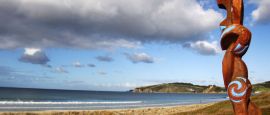Wellington History
Thriving Wellington hasn’t let earthquakes, civil unrest or industrial decline get in its way. No wonder it’s branded the ‘coolest little capital’ in the world.
First to arrive (around the 10th century) was the Polynesian explorer Kupe, who named the harbour Te Whanganui a Tara (the Great Harbour of Tara) after his son.
The London-based New Zealand Company ship, Tory, sailed up in 1839. The subsequent signing of the Port Nicholson Purchase deed allocated 10% of the purchased land to the signatory Maori chiefs and their families. The rest was to be sold to British settlers.
A fledgling settlement called Britannia sprung up, later renamed Wellington.
Despite an earthquake in 1855 causing massive damage, the colony became a prosperous commercial centre and in 1865 superseded Auckland as the capital.
In the early 20th century, Wellington was characterised by a number of industrial struggles, which lead to the great strike of 1913, and the largest outbreak of civil unrest ever seen in New Zealand.
War then broke out, and when it ended in 1918, soldiers returning home carried with them a deadly influenza virus, which caused a nationwide epidemic. In Wellington alone, it claimed more than 750 lives.
The 1920s brought unemployment and depression, and the outbreak of WWII and the Japanese bombing of Darwin in 1942 led to the arrival of 20,000 US marines.
After the war, thousands lined the streets to greet the newly crowned monarch, Queen Elizabeth II in 1954.
In the 1970s, Wellington’s port declined and the waterfront became an industrial wasteland. In the last few decades however, it’s been transformed into an attractive mix of restaurants, bars, offices, art galleries and heritage trails.
Today, tourism is booming and is a mainstay of Wellington’s economy.
Did you know?
• Wellington’s cable car began whisking locals and visitors from Lambton Quay to the Kelburn lookout in 1902.
• According to legend, the distinctive ‘Beehive’ parliament building was sketched as a joke on a napkin.
• At the beginning of the 21st century, Wellington’s inner-city population jumped by 41% in five years.
Do you have any Feedback about this page?
© 2025 Columbus Travel Media Ltd. All rights reserved. No part of this site may be reproduced without our written permission, click here for information on Columbus Content Solutions.




 You know where
You know where